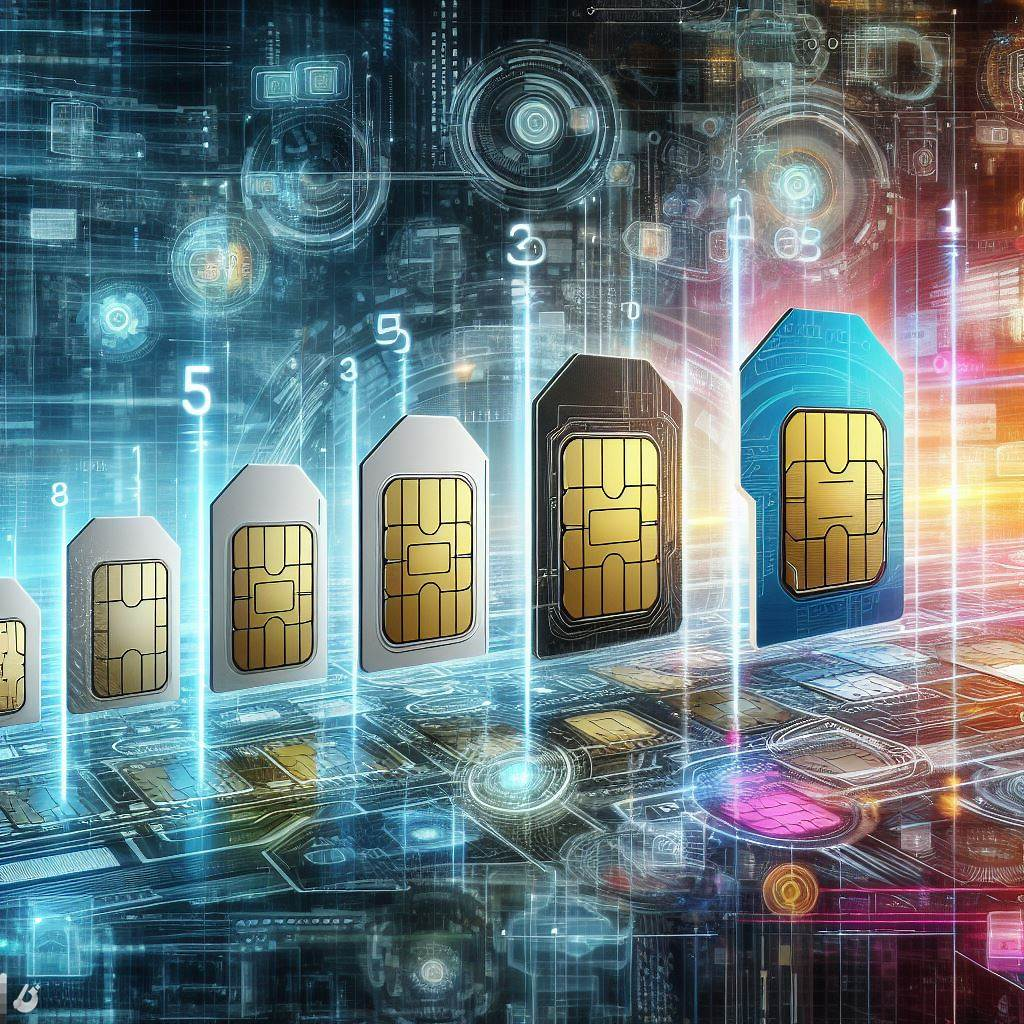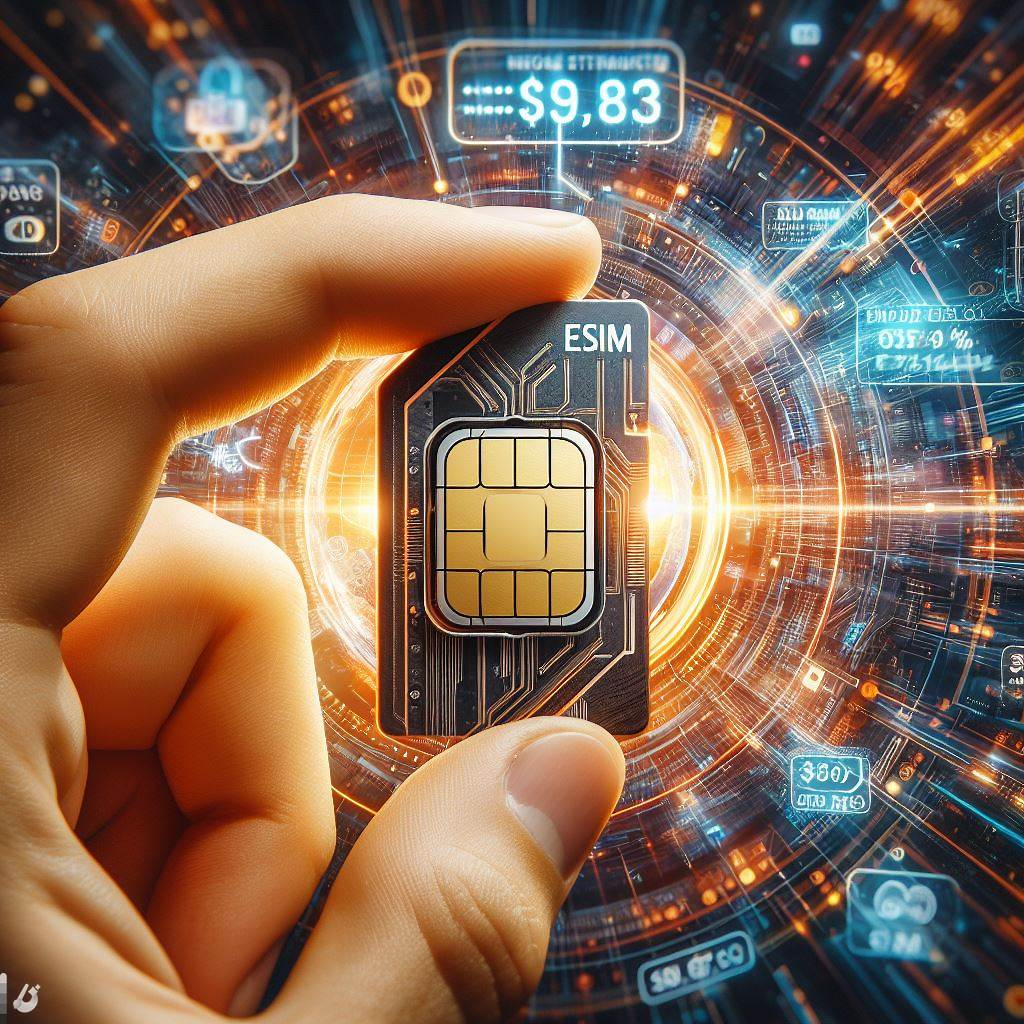eSIMs Explained: Redefining Connectivity in the Digital Era
Published by
Jan 17 2024

The Evolution of SIM Cards: From Physical SIM Card to eSIMf

Tracing the evolution of SIM card technology.
Sim cards have come a long way since their inception. Initially, the subscriber identity module (SIM) cards were physical cards that contained a chip with data required for mobile phone communication. These physical SIM cards were inserted into mobile devices, allowing users to connect to their respective mobile networks. However, with the advancement of technology, a new era of sim cards emerged: eSIMs.
eSIMs, also known as embedded SIMs or virtual SIMs, are a digital alternative to the traditional physical SIM card. Unlike physical SIM cards, eSIMs are built into the mobile device itself, eliminating the need for a physical card. This means that users no longer have to worry about misplacing or damaging their physical SIM cards. With eSIMs, the subscriber identity module is integrated directly into the device, making it more convenient for users to switch between different mobile networks without the hassle of changing physical SIM cards.
Understanding the Subscriber Identity Module (SIM) Card
When it comes to understanding the Subscriber Identity Module (SIM) card, it’s important to recognize its significance in the world of mobile technology. A physical SIM card, short for Subscriber Identity Module, is a small, removable card that is inserted into a cell phone or other mobile device to identify and authenticate the user. Traditionally, SIM cards were physical cards that were inserted into a dedicated slot in the device. However, with the advent of eSIM technology, the landscape of SIM cards is evolving.
The emergence of eSIMs, or embedded SIMs, has brought about a new wave of convenience and flexibility for users. Unlike traditional SIM cards, eSIMs are embedded within the device and do not require a physical SIM card slot. This not only allows for a more streamlined design, but also provides the ability to support multiple mobile networks. For example, the iPhone XS is one of the flagship models that supports eSIM, allowing users to have two cellular plans on a single device. This advancement in technology is transforming the way we think about SIM cards, offering more options and possibilities for users in an increasingly connected world.
Exploring the Benefits of eSIM Technology

Navigating the benefits of eSIM technology.
With the advent of eSIM technology, there are numerous benefits that users can enjoy. One of the key advantages is the ability to have multiple phone numbers on a single device. With traditional removable SIM cards, users often had to switch SIM cards or carry multiple phones to access different numbers. However, with eSIMs, users can have multiple virtual SIM cards on one device, making it much easier to manage different phone numbers for personal, work, or travel purposes.
Another benefit of eSIM technology is the flexibility it offers in terms of carrier support. Unlike traditional removable SIM cards, eSIMs are not tied to a specific carrier. This means that users have the freedom to switch between carriers without the need to physically change their SIM card. For example, a Global Yo’s customer with an eSIM-enabled device can easily switch to a different carrier that supports eSIM technology without any hassle. This flexibility allows users to choose the best carrier for their needs and take advantage of different plans and offers without the limitations of removable SIM cards.
How eSIMs are Changing the Mobile Phone Industry
The introduction of eSIM technology has brought significant changes to the mobile phone industry. With traditional SIM cards, users are required to physically insert a SIM card into their phones to make phone calls or access mobile data. However, eSIMs eliminate the need for physical SIM cards by using virtual SIM technology. This innovation has revolutionized the way we use our cell phones, making the process of activation and switching between carriers much simpler and more convenient.
With eSIMs, users can easily switch between different mobile networks without having to physically change their SIM card. This is especially beneficial for frequent travelers or individuals who need to switch carriers for various reasons. By scanning a QR code or downloading a carrier profile, users can activate their eSIM and start using their phone immediately. This technology has been embraced by major carriers like Global Yo, further supporting its adoption in the industry.
The Rise of Dual SIM Devices: eSIMs vs. Traditional SIM Cards

Comparing the two technologies in dual SIM devices.
The introduction of dual SIM devices has brought about a significant change in the way we use our mobile phones. With the rise of eSIMs, we now have the option to use multiple wireless services on a single device. Take, for example, the iPhone XR, which comes with eSIM support. This means that users can have both a traditional SIM card and an eSIM compatible device, allowing them to switch between wireless service providers seamlessly. This flexibility opens up a world of possibilities, especially for those who travel frequently or who require different wireless plans for work and personal use.
One of the main advantages of dual SIM devices is the ability to have two separate phone numbers on a single device. This can be particularly useful for individuals who want to keep their personal and professional lives separate, or for those who want to take advantage of different plans from different service providers. With an embedded SIM card like eSIM, there is no need to physically swap out SIM cards when switching between numbers.
Furthermore, with eSIMs, it is now possible to connect additional devices, such as an Apple Watch, to your mobile plan without the need for a separate SIM card. This added convenience enhances the overall user experience and further solidifies the rise of dual SIM devices in the mobile phone industry. Overall, the introduction of eSIMs in dual SIM devices has brought about increased flexibility and convenience for users, allowing them to take full advantage of multiple wireless service options without the hassle of physically swapping SIM cards.
Unlocking the Potential of eSIMs: A Look at Apple’s iPhone Models
The introduction of eSIM technology has revolutionized the way we use mobile devices. Apple, one of the leading manufacturers in the industry, has embraced this innovation in their iPhone models. With eSIM devices, users can now have multiple phone numbers on the same device, eliminating the need for physical SIM cards. This flexibility allows individuals to switch between different service providers without the hassle of swapping out SIM cards. The eSIM technology ensures seamless cellular connectivity that is compatible with various mobile networks, offering users a reliable and convenient experience.
Apple’s iPhone models, starting from the iPhone XS and XR, have incorporated eSIM capabilities. This feature has opened up new possibilities for users, providing greater freedom and flexibility when it comes to managing their mobile networks. By utilizing eSIM adoption, iPhone users can easily switch between carriers, simplifying the process of changing service providers. This is a significant advantage compared to traditional SIM cards, where users would have to physically swap out the card or purchase a new one altogether. As eSIM technology continues to gain momentum, other smartphone manufacturers, such as Google with their Pixel devices, are also starting to embrace this innovation, further solidifying its place in the future of mobile connectivity.
Exploring the Compatibility of eSIMs with Different Mobile Networks

Exploring the global compatibility of eSIMs.
One of the key advantages of eSIMs is their compatibility with different mobile networks. Unlike traditional SIM cards, which are tied to a specific network, eSIMs allow users to switch between networks without needing to physically change the SIM card. This flexibility is particularly beneficial for individuals who travel frequently or need to switch carriers for various reasons.
For instance, iPhone models starting from iPhone XR and newer offer eSIM services, enabling users to use both a physical card and a digital version simultaneously. This dual SIM capability allows users to switch between networks seamlessly, based on their preferences or location, without the need to carry multiple physical SIM cards. Moreover, eSIMs also offer the convenience of transferring data, such as text messages and stored contacts, between devices, making the process of switching phones much smoother.
Overall, by exploring the compatibility of eSIMs with different mobile networks, users can take advantage of the flexibility and convenience they provide. Being able to switch between networks without the hassle of physically changing SIM cards and effortlessly transferring data between devices are just a few examples of how eSIM technology is revolutionizing the mobile phone industry. As more devices adopt eSIM capabilities and more mobile networks offer eSIM services, the potential for seamless connectivity across networks becomes even more promising.
How to Activate and Set Up an eSIM on Your Device
To activate and set up an eSIM on your device, you will first need to check if it is supported by your mobile carrier. Some carriers may charge an additional fee for eSIM activation, so it’s important to inquire about any associated costs beforehand. Once you have confirmed compatibility and addressed any payment requirements, the next step is to install the eSIM profile.
To install the eSIM profile, navigate to the Settings menu on your device. Look for the ‘Mobile Data’ or ‘Cellular’ option, and select it. From there, you should find an option to ‘Add Data Plan’ or ‘Add Cellular Plan.’ Choose this option and then scan the QR code provided by your carrier or enter the activation code manually. The device will proceed to download the eSIM profile and configure it on the embedded chip.
After the installation process is complete, ensure that the eSIM is set as the default data plan for your device. This can typically be done within the ‘Mobile Data’ or ‘Cellular’ settings. Enable the eSIM profile for data usage, calls, and messaging, and deactivate any other existing physical SIM cards.
It’s important to note that while you may have successfully activated the eSIM, certain functionalities like using the camera app with the eSIM profile may require a separate setup. Additionally, if you travel internationally and want to switch to a local carrier’s network, make sure to deactivate the eSIM profile and follow the activation steps for the new carrier.
Comparing the Costs of eSIMs and Traditional SIM Cards

Hold the tangible representation of costs in your hands.
The cost comparison between eSIMs and traditional SIM cards is an important consideration for consumers and businesses alike. When it comes to traditional SIM cards, purchasing and activating a new card can be a hassle. Not only do you need to physically insert the card into your phone’s SIM slot, but you may also need to contact your carrier or visit their store to get it activated. Additionally, if you switch devices frequently or have multiple devices, you may need to purchase separate SIM cards for each. This can quickly become costly, especially if you factor in the cost of unlocking your device’s camera settings app for each SIM change.
On the other hand, eSIMs offer a more convenient and potentially cost-effective alternative. With an eSIM compatible device, such as the Motorola Razr or the latest smartphone models from major device makers, you can easily switch between carriers and cellular plans without the need for physical SIM cards. Most major carriers support eSIM activation, making it easier than ever to switch providers or plans. This flexibility allows you to optimize your cellular plan based on your usage patterns and budget, potentially saving you money in the long run.
Unlocking the Convenience of eSIMs: Switching Devices Made Easy
Switching devices has never been easier, thanks to the convenience of eSIMs. By using an eSIM, users can seamlessly transfer their phone service from one device to another without the hassle of physically swapping out a SIM card. The activation process for an eSIM is straightforward and can be done easily through the device settings. Gone are the days of having to contact a service provider or visit a physical store to get a new SIM card activated. With an eSIM, users can activate their service plans directly on the device, eliminating the need for a physical SIM card altogether.
One of the key advantages of using an eSIM is its ability to be used across many devices. Whether you’re switching from a smartphone to a smartwatch or from a tablet to a laptop, the eSIM can be easily transferred to the new device. This flexibility saves users time and effort, as they no longer need to obtain a new SIM card each time they switch to a different device.
The Future of Mobile Connectivity: eSIM Adoption and Beyond

Picturing the future of mobile connectivity through eSIM adoption.
In recent years, eSIM technology has revolutionized the mobile phone industry, paving the way for the future of mobile connectivity. With the rise of dual SIM devices and the increased compatibility of eSIMs with different mobile networks, the adoption of eSIMs is set to soar in the coming years.
One key advantage of eSIMs is their ability to make switching devices much easier. Gone are the days of physically swapping out SIM cards and transferring contacts and data. With eSIMs, users can simply activate their eSIM on the new device and instantly have access to their mobile connectivity. This convenience is not only beneficial for individual consumers but also for businesses that rely on seamless device management and fleet connectivity.
The future of mobile connectivity does not stop at eSIM adoption. As technology continues to advance, we can expect to see further innovation in the field. From improved network efficiency to enhanced security measures, the possibilities are endless. As more industries embrace the Internet of Things (IoT), eSIMs will play a vital role in connecting and managing a wide range of devices, from wearables to smart home appliances. With the potential for faster speeds and increased reliability, eSIMs are poised to offer a truly seamless mobile connectivity experience in the years to come.

Glimpsing into the future of mobile connectivity.
What is an eSIM?
An eSIM, short for embedded SIM, is a digital SIM card that is integrated into mobile devices. It eliminates the need for a physical SIM card and allows users to switch between mobile networks without changing SIM cards.
How does an eSIM work?
An eSIM works by storing multiple SIM profiles digitally on the device. Users can activate or switch between these profiles using software rather than physically swapping SIM cards. The device connects to the mobile network using the selected profile.
What are the benefits of eSIM technology?
eSIM technology offers several benefits, including the ability to switch mobile networks without changing SIM cards, reduced reliance on physical components, streamlined device setup and activation, and improved security and flexibility for users.
How are eSIMs changing the mobile phone industry?
eSIMs are revolutionizing the mobile phone industry by allowing device manufacturers to create thinner and more compact devices without the need for a physical SIM card slot. It also enables dual SIM functionality, making it easier for users to manage multiple mobile numbers or switch between networks.
What is the difference between an eSIM and a traditional SIM card?
The main difference between eSIM cards and traditional SIM cards is that eSIMs are embedded within the device and do not require physical insertion or removal. eSIMs also offer the flexibility of switching between networks without needing to physically switch SIM cards.
How do eSIMs work with different mobile networks?
Embedded SIM cards are compatible with various mobile networks, and users can activate different profiles from different carriers on the same device. However, the specific compatibility and availability of eSIMs may vary depending on the mobile network and the device being used.
How do I activate and set up an eSIM on my device?
To activate and set up an eSIM on your device, you need to follow the instructions provided by your mobile network operator. Typically, this involves scanning a QR code or entering an activation code to download and install the eSIM profile onto your device.
How do the costs of eSIMs compare to traditional SIM cards?
The costs of eSIMs and traditional SIM cards can vary depending on the specific mobile network and the service plans offered. While some mobile networks may charge a fee for eSIM activation, others may offer it as a free service. It is best to consult with your mobile network operator for the specific cost details.
Can I easily switch devices with an eSIM?
Yes, eSIMs make switching devices significantly easier. Since the eSIM profile is stored digitally, users can transfer their eSIM profile from one device to another without the need for removable SIM card swapping. This feature adds convenience and flexibility for users.
What does the future hold for eSIM adoption?
The future of eSIM adoption looks promising. As more mobile device manufacturers embrace eSIM technology and more mobile networks offer eSIM support, we can expect to see wider adoption and integration of eSIMs across various devices, including smartphones, tablets, wearables, and other IoT devices.

